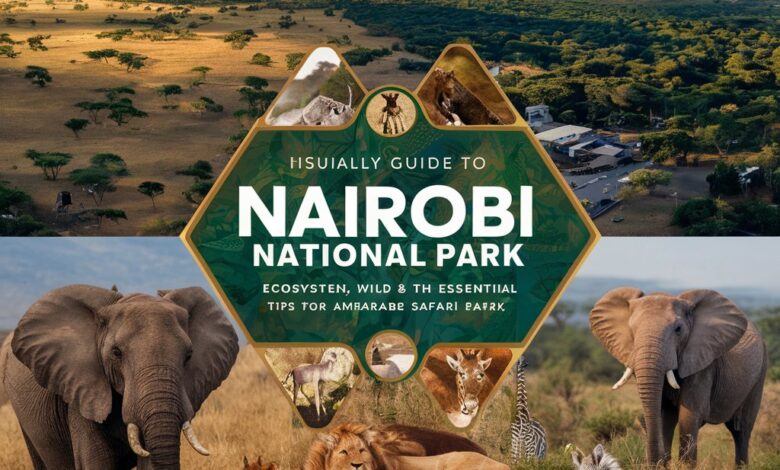

Nairobi National Park stands as a testament to conservation efforts amidst urban sprawl, offering a unique experience where wildlife and cityscape harmoniously coexist. Located just a stone’s throw away from Kenya’s bustling capital, Nairobi, this park holds a special place in the hearts of locals and tourists alike. Spanning over 117 square kilometers, it’s not only Kenya’s oldest national park but also one of the most accessible wildlife sanctuaries globally. Let’s delve into the depths of Nairobi National Park in this comprehensive guide, exploring its history, biodiversity, attractions, and visitor information.
History and Conservation Efforts
Established in 1946, Nairobi National Park was born out of the need to safeguard Kenya’s diverse wildlife population against increasing human encroachment. Originally covering 28,963 acres, the park has since undergone expansions to mitigate threats posed by urbanization. Today, it serves as a critical refuge for endangered species such as black rhinos, lions, giraffes, and cheetahs.
The park’s proximity to Nairobi’s urban core symbolizes a delicate balance between development and conservation. Over the years, it has faced numerous challenges, including habitat fragmentation and human-wildlife conflicts. However, concerted efforts by conservation organizations, government agencies, and local communities have helped preserve its ecological integrity and foster sustainable coexistence.
Biodiversity
Despite its modest size, Nairobi National Park boasts a remarkably diverse ecosystem, encompassing savannah grasslands, acacia woodlands, and riverine forests. Its varied habitats support an array of wildlife species, making it a prime destination for nature enthusiasts and photographers.
The park is renowned for its charismatic megafauna, including the iconic African elephant and buffalo. Visitors can also spot elusive predators such as leopards and hyenas prowling the savannah, while cheetahs dart across the plains in pursuit of prey. Nairobi National Park is also a haven for birdwatchers, with over 400 avian species recorded within its boundaries, including ostriches, secretary birds, and martial eagles.
Attractions and Points of Interest
Nairobi National Park offers an array of attractions and activities tailored to diverse interests. Here are some highlights:
1.Game Drives: Embark on an exhilarating wildlife safari adventure through the park’s network of gravel roads, guided by experienced rangers. Witness herds of wildebeests grazing peacefully, majestic lions basking in the sun, and graceful giraffes silhouetted against the horizon.
2.Ivory Burning Site Monument: Pay homage to Kenya’s commitment to wildlife conservation at the Ivory Burning Site Monument, commemorating the historic event where tons of confiscated ivory were set ablaze to combat poaching and illegal trade.
3.Nairobi Safari Walk: Explore the Nairobi Safari Walk, an educational facility adjacent to the park entrance, featuring informative exhibits on Kenya’s diverse ecosystems, conservation initiatives, and indigenous flora and fauna.
4.Animal Orphanage: Visit the Nairobi Animal Orphanage, a rehabilitation center for orphaned and injured wildlife, including lion cubs, cheetahs, and rhinos. Learn about the orphanage’s conservation efforts and the challenges faced in nurturing and reintegrating orphaned animals into the wild.
Visitor Information
Before embarking on your Nairobi National Park adventure, here are essential details to consider:
Entrance Fees: Visitors are required to pay entrance fees, with separate rates for Kenyan citizens, residents, and international tourists. Additional charges may apply for guided tours and vehicle access.
Operating Hours: The park is open daily from dawn to dusk, with early morning and late afternoon considered optimal times for wildlife viewing.
Accessibility: Nairobi National Park is easily accessible from Nairobi’s city center, located approximately 7 kilometers southeast of the central business district. Visitors can access the park via self-drive private vehicles, taxis, or organized tours.
Facilities: The park features picnic sites, restroom facilities, and designated viewpoints offering panoramic vistas of the Nairobi skyline and the park’s lush landscapes.
Guided Tours: Consider booking guided tours led by knowledgeable naturalists and rangers to enhance your wildlife encounters and gain insights into the park’s ecology and conservation efforts.
Conservation Challenges and Future Prospects
While Nairobi National Park has made significant strides in wildlife conservation, it continues to face multifaceted challenges, including habitat degradation, poaching, and human-wildlife conflicts. As Nairobi’s urban footprint expands, the park’s ecological integrity remains under constant threat, necessitating proactive measures to mitigate adverse impacts and foster sustainable coexistence between humans and wildlife.
Looking ahead, the park’s long-term viability hinges on collaborative efforts aimed at enhancing habitat connectivity, strengthening anti-poaching initiatives, and promoting community-based conservation initiatives. By engaging local communities, leveraging innovative conservation technologies, and fostering public awareness and stewardship, Nairobi National Park can serve as a model for urban conservation worldwide.
Certainly! Here are some frequently asked questions (FAQs) about Nairobi National Park:
1. What is Nairobi National Park?
Nairobi National Park is a wildlife sanctuary located just outside Kenya’s capital city, Nairobi. It’s known for its unique setting where wildlife and the urban environment coexist, making it a significant conservation area and a popular tourist destination.
2. When was Nairobi National Park established?
The park was established in 1946 to protect Kenya’s diverse wildlife population from urban encroachment. Since then, it has expanded and evolved to safeguard endangered species and their habitats.
3. What kind of wildlife can I expect to see in Nairobi National Park?
The park boasts a rich diversity of wildlife, including iconic African species such as lions, giraffes, black rhinos, cheetahs, and buffaloes. It’s also a haven for birdwatchers with over 400 bird species recorded.
4. What are the main attractions within Nairobi National Park?
Key attractions include:
- Game Drives: Visitors can embark on guided safari drives to observe wildlife in their natural habitat.
- Ivory Burning Site Monument: A historic site commemorating efforts to combat poaching.
- Nairobi Safari Walk: An educational facility showcasing Kenya’s ecosystems and wildlife conservation.
- Nairobi Animal Orphanage: A rehabilitation center for orphaned and injured animals.
5. How can I visit Nairobi National Park?
The park is conveniently located approximately 7 kilometers southeast of Nairobi’s city center. Visitors can access it via self-drive vehicles, taxis, or organized tours. Entrance fees apply, with different rates for Kenyan citizens, residents, and international tourists.
6. What are the operating hours of Nairobi National Park?
The park is open daily from dawn to dusk, with early mornings and late afternoons being optimal times for wildlife viewing due to cooler temperatures and active animal behavior.
7. What facilities are available inside Nairobi National Park?
Facilities include picnic sites, restroom facilities, and designated viewpoints offering panoramic views of Nairobi’s skyline and the park’s landscapes. Guided tours led by knowledgeable rangers are also available for enhanced wildlife experiences.
8. What conservation challenges does Nairobi National Park face?
Despite its successes, the park faces challenges like habitat degradation, poaching, and human-wildlife conflicts due to Nairobi’s urban growth. Efforts are ongoing to strengthen conservation initiatives and promote sustainable coexistence between wildlife and humans.
9. How can I contribute to the conservation efforts at Nairobi National Park?
Visitors can support conservation by respecting park rules, participating in guided tours that promote awareness, and learning about local wildlife conservation initiatives. Supporting local communities engaged in conservation also plays a crucial role.
- Why should I visit Nairobi National Park?
Nairobi National Park offers a unique opportunity to experience African wildlife against the backdrop of a bustling city. Its rich biodiversity, accessibility, and conservation efforts make it a must-visit destination for nature enthusiasts, photographers, and anyone interested in wildlife conservation.
Conclusion
Nairobi National Park stands as a beacon of hope in the realm of wildlife conservation, offering a sanctuary where nature and civilization converge. Its rich biodiversity, coupled with its proximity to Kenya’s vibrant capital, makes it a must-visit destination for nature enthusiasts, photographers, and conservation advocates alike.
As we celebrate Nairobi National Park’s legacy of preservation and resilience, let us reaffirm our commitment to safeguarding our planet’s precious natural heritage for generations to come. Through collective action and unwavering dedication, we can ensure that Nairobi National Park remains a symbol of Kenya’s enduring conservation ethos and a source of inspiration for future generations to cherish and protect our planet’s irreplaceable biodiversity.







